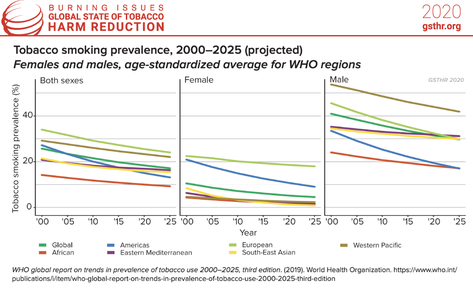Tobacco Smoking Prevalence
Tobacco Smoking Prevalence
Knowledge•Action•Change (2020)- Burning Issues: The Global State of Tobacco Harm Reduction 2020


Historically, most countries have seen a rise and then a decline in smoking. A general decline in rates of smoking is apparent across all global regions, and for both sexes. This has been especially marked in many higher-income countries. Rates of smoking have fallen for both men and women largely due to greater public awareness of the importance of a healthier lifestyle, as well as the introduction of various tobacco control measures including advertising bans, smoke-free environments, and higher taxation. Nevertheless, reduction in smoking prevalence tends to start plateauing at around 20% of a population, suggesting diminishing returns on tobacco control interventions.
What these data show is that millions of people are still smoking, many of whom will want to, but have been unable, to quit. We discuss this in later chapters, where we consider the limits of tobacco control interventions and the need to adopt harm reduction measures for people who don’t want to smoke but want to continue using nicotine.
See also p.32 of the report: Burning Issues: The Global State of Tobacco Harm Reduction 2020